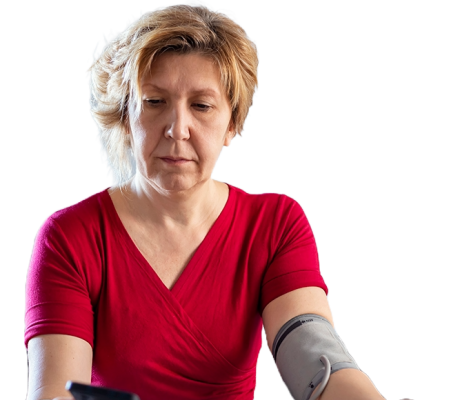
The Blue KC Care Management app resource library makes it easy to get your health questions answered. Download it now and use access code kcwsqcare.
These tips make it easy to order your meal and enjoy it with confidence.

Watching what you eat is key when you have diabetes. That may feel easier to do when you’re in the comfort of your own kitchen. You can decide what goes into each home-cooked dish. You can read food labels and measure serving sizes to meet your dietary needs.
Navigating a restaurant menu, on the other hand, may feel like you’ve lost that control. While eating out should be a treat, you may find it confusing or even overwhelming when you have diabetes.
Here’s the good news for food lovers: Dining out doesn’t have to be stressful when you have diabetes. The trick is to have a plan and go armed with a bit of helpful information. These six tips can help you savor every bite while keeping your blood sugar levels in check.
Your doctor or diabetes educator probably shared a total number of carbohydrates you should aim to eat in a day. They also likely explained how those carbohydrates should be spread out across snacks and meals. Knowing that, it may be tempting to “save up” some of your daytime carbohydrates for a splurge later.
But diabetes doesn’t work that way, says Kristen Smith, a registered dietitian. Smith is a spokesperson for the Academy of Nutrition and Dietetics and founder of the blog 360 Family Nutrition. Slashing your carbs at lunch and then doubling up at dinner causes blood sugar swings that are hard to manage. “You want to keep your carbohydrate intake consistent throughout the day to avoid significant fluctuations and possible spikes in your blood sugar,” says Smith.
Let’s say you generally aim for 50 grams of carbohydrates at lunch and 50 grams at dinner. Your goal: Stick to that plan even when you’re eating out.
Pop quiz: Which has more carbohydrates, miso salmon or herb-crusted salmon? If you peeked at the Cheesecake Factory’s online menu, you might be surprised by the answer: The herb-crusted (as in, breaded) salmon has less than half the carbs of the miso option.
The lesson here? Spend a few minutes looking at the menu before you go to the restaurant to map out an informed plan, says Smith. Many restaurants share their nutrition information online. Use that (or the meal descriptions) to think through your options at home with a clear mind. That way, by the time you’re hungry and at the restaurant, you can stick to your plan and beat the urge to splurge.
Food portions at restaurants tend to be larger than what you’d dish up at home, according to the USDA. That’s probably not news if you’ve ever been served a heaping pile of pasta or tower of fries. Still, even knowing it’s too much food, it’s easy to overeat when it’s right in front of you.
The key is to be intentional about how much you eat. Decide, for instance, that half a burger plus a side salad is ideal for your meal. Or aim to eat one cup of cooked pasta, rather than the entire plate. “At a restaurant, you’re probably not going to pull out your measuring cups,” says Smith. But your hand can act as a decent guide: A closed fist is roughly the same amount as one cup of grains, veggies, or fruit. The palm of your hand is about half a cup.
Worried you’ll be tempted to eat more than you want? Ask your server to wrap up half your meal before it even hits the table. Or if that feels uncomfortable, bring a to-go container with you and do it yourself.

The Blue KC Care Management app resource library makes it easy to get your health questions answered. Download it now and use access code kcwsqcare.
You probably know that the dessert menu is sugar central. But you might not realize that many sauces and other condiments can be loaded with added sugars as well. Each tablespoon of ketchup, for instance, has 5 grams of carbohydrates. That can quickly add up! Smith suggests asking for all sauces, dressings, and condiments on the side so you can better control how much you eat. Also, embrace lower-sugar condiments such as mustard, salsa, and hot sauce.
Keep hidden sugars in mind when reading the menu as well. Red-flag words include:
If a dish has one of those words in it, ask for more details about how it is made. Or think about having a smaller portion.
Having diabetes doesn’t mean entire sections of the menu are completely off-limits. But it might mean having just a few bites of an appetizer or dessert rather than the whole thing. Splitting with a friend or the entire table is an easy way to indulge without overdoing it. And even if your dinner dates aren’t managing diabetes, they might appreciate that splitting means savoring a dish in a healthier way.
Not all drinks are created equally. Wine and straight spirits contain almost no carbohydrates. But cocktails such as Bloody Marys, margaritas, and piña coladas can be sugar bombs. A pina colada, for example, can have 40 grams or more of carbohydrates. It’s also important to know that alcohol can affect judgment. That can make it harder to stick to your eating intentions.
If you want an alcoholic drink, pick one that fits within your eating plan. Then switch to a no-carb or very low-carb alternative, such as seltzer with a lemon wedge.
Additional sources:
Carb counting: Centers for Disease Control and Prevention
Nutritional info: The Cheesecake Factory
America’s eating-out habits: USDA
Fast food tips: American Diabetes Association
Eating out tips: Centers for Disease Control and Prevention
Alcohol and diabetes: American Diabetes Association
Carbs in piña colada: Carb Manager